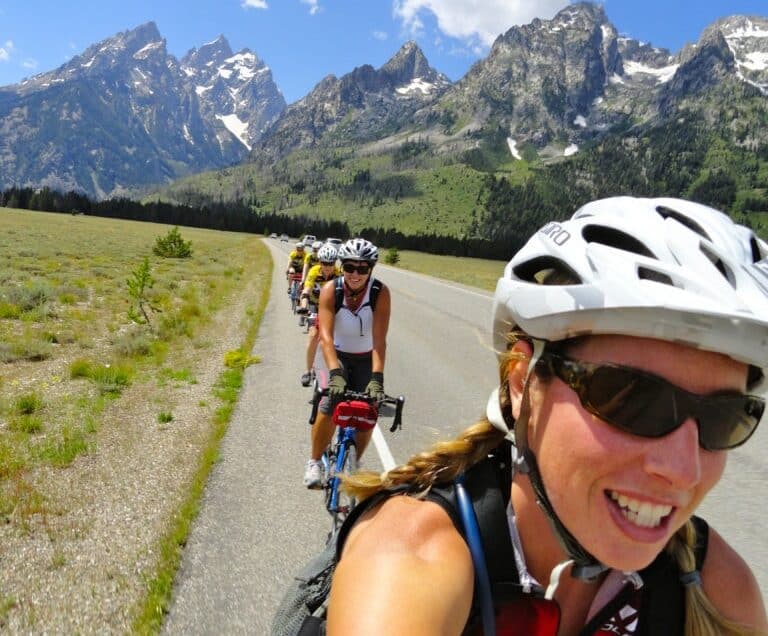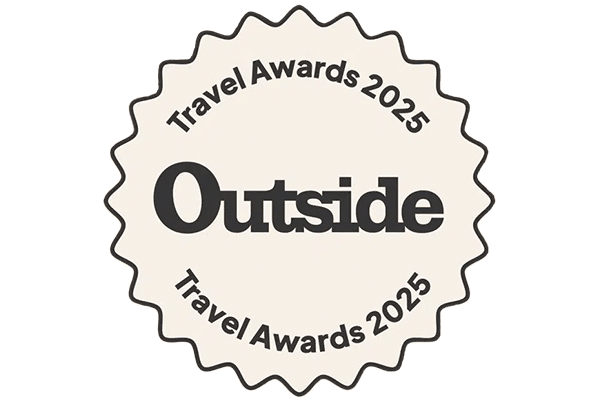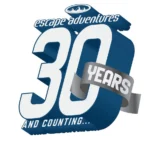Escape Adventures offers a spectacular summer Grand Tetons road bike tour
Day 1: From our rendezvous spot in Idaho Falls, we shuttle a brisk if enjoyable 145-miles to the National Oregon/California Nature Center (Montpelier, Idaho). After taking in the experience of our own brave 19th century economic refugees, who journeyed from Missouri to Oregon—and crossed this very spot doing so, captured and interpreted at the center—we begin to envision our own collective epic. This, while trip leaders prepare your bikes. Our route, following what’s known as the Lotoja stage, launches in go-big fashion with a climb over Geneva Pass. A tongue-wagging descent on the other side brings us to a beautiful lunch spot. (The first in what promises to be a blur of big, wild beauty.) After lunch, the next climb takes us over Salt Pass: elevation 7630-ft., a stunning, if truly brawny plateau atop the Bridger-Teton National Forest. Now 30-miles north of Montpelier—on US-89—the next stage parallels the north-trending Snake River, flowing into Star Valley. Forty-five miles long, and defined by a handful of widespread ranching communities, Star Valley’s attributes stretch from wildlife to unsurpassed outdoor access to spectacular, high country scenery. Though without question, the highlight of today’s stage is Intermittent Spring. Erupting at consistent 15 to 20 minute intervals, this cold-water geyser, recognized as the world’s largest, represents one of only three of its type to have ever been discovered. From a Wyoming type spritz, we overnight five miles east of the spring, in cowboy comfort at the nearby Afton High Country Inn. As St. Louis has its Gateway Arch, Afton (pop. 1181) announces itself with a 75-ft wide span of 3,000 elk antlers stretched over four lanes of US-89.
Day 2: Today’s stage continues a northerly arc: surging through the broad-in-the-shoulders Star Valley, our routing shoots towards Jackson, Wyoming; and, ultimately to the mouth of the Snake River. A 1078-mile tributary of the Columbia, the Snake River originates in Wyoming. Discharging 54,830-cubic feet per second (on average), the Snake then carves its way across Southern Idaho. On fast, grabby Kevlar skins, we surge through the same spot where Ansel Adams shot his iconic, 1942 black and white image: the Snake river–also called Mud, Shoshone and Yam-pah-pa—bent at a serpent-like hard right beneath the 13,775-ft high Tetons. Today’s stage, at an average 1.9% grade takes a dramatic bump in elevation before we sweep through the powerfully built Snake River Gorge, then ultimately into the mountains that front Jackson. Tonight we decompress at the plush 5-star Lexington at Jackson. You earned those high thread-count sheets.
Day 3: Today’s stage launches from Jackson, the phenomenal majesty of the 40-mile long Tetons spread akin to a royal procession, pushed up to the sky’s very edge before our humble peloton. Our route stays within the 310,000-acre Grand Teton National Park. Along with 2.2-million acre Yellowstone National Park ten miles to the south, plus adjoining national forests, we’re immersed in, and moreover nurtured by no less than 18-million acres of wilderness. Called the Greater Yellowstone Ecosystem, our group experiences the world’s largest intact biome or bionetwork (at mid latitude). Put another way, we’re cycling amidst the largest concentration of big and small mammals in the Lower 48: Wyoming moose to Grizzly bear, wolf, Bison and Bighorn sheep, elk, Black bear, Pronghorn antelope to puma, Mountain goat, otter, Bald eagle, Pine Marten to Marmot. This deep dive into a cold and high Serengeti closes out at the Park’s eastern edge, in the small gateway community of Moran Junction. A high altitude village that routinely sees winter temperatures in the 50-60 below range, Moran Junction can also claim John Wayne’s toil. In the late 1930s, Wayne helped build cabins for cast and crew while on location here for The Big Trail. Leaving Teton National Park, we cross into the 3.4-million acre Bridger-Teton National Forest, the third largest outside Alaska. We will find the welcome mat at The Hatchet Resort.
Day 4: Another day, another embarrassment of riches. With a shuttle into Yellowstone National Park, we stop to take in West Thumb: a large, stand-alone geyser basin on the shores of Lake Yellowstone, West Thumb has the look of a mini Crater Lake. Departing from the 14 by 20-mile Yellowstone Lake, at 7732-ft. elevation, today’s stage proceeds clockwise around YNP, ultimately crossing the Continental Divide. Once Yellowstone’s roads are cleared of snow, road cycling season begins. (Until April, cars are verboten.) Our stage follows the route of the Old Faithful Cycle Tour. Timed for late summer’s thinning crowds, Aspens showcasing their best gold bling, and elk making long distance calls, our peloton sweeps toward Isa Lake—straddling the Continental Divide—and onto the Kepler Cascades. At 8262-ft., Isa Lake is a hydrologic oddball. One of only two lakes in the world that drains backwards, Isa’s east spills out toward the Pacific; while its west tumbles towards the Gulf of Mexico. Kepler, conversely, keeps it real: as in really stunning cascades, plunging 150-ft. over multiple drops. The midway point of today’s stage unfolds at Old Faithful with a lunch stop. Blowing every 44 to 125-minutes, Old Faithful’s cone geyser reaches a height of 106 to 185-ft. Remounting, we cycle further into geothermal Disneyland, sweeping past a phantasmagoric succession of percolating mud pots, hot springs and belching fumaroles: from Morning Glory Pool to Biscuit Basin, and the Grand Prismatic Spring, all fed by an upper mantle reactor of volcanic magma. Surging toward Madison Junction we pass the site where—so goes the legend—the 19th Washburn exploratory party first floated the idea of preserving this blessed landscape in perpetuity. Wrapping in either West Yellowstone or Canyon Village, we enjoy dinner, bookended by time for souvenir shopping. Our beautiful hotel setting is in either Canyon Lodge and Cabins, Yellowstone, or Bar N Ranch, West Yellowstone.
Day 5: After a by turns hearty and superb breakfast, a our stage loops back around Yellowstone National Park, ultimately towards West Thumb. Near Artist Point, we stop to hike two-miles down to the breathtaking Grand Canyon of the Yellowstone River. The roaring splendor of the Upper and Lowers Falls unfolds before us from a canyon overlook, conjuring an open-air Imax Theatre, its columns plunging dramatically into the Yellowstone River. A tributary of the Missouri River, the 692-mile long Yellowstone was so named for the yellow sandstone bluffs highlighting the canyon walls. Sweeping across Hayden Valley in gorgeous afternoon light, the opportunity to glimpse big, charismatic wildlife becomes manifest. From Lake Village and the stage’s culmination alongside Yellowstone Lake, we shuttle back to Hatchet Resort.
Day 6: Staying true to our extra bold theme, our closeout day begins with a Wyoming country breakfast. Next we shuttle to the bike path that sweeps in smart fashion alongside the base of the celebrated Jackson Hole ski resort. A nine-mile scenic spin shoots from Teton Village to the quaint, Old West town of Wilson. The next stage climbs Teton Pass; then surges toward Victor. Yes, a climb that might turn your calves into Buffalo wings. Inasmuch, hauling over the old highway is how Jackson’s cycling culture defines vertical integration. We see it as the maximum compensation package: a challenging week in the saddle wrapped in a finale of elite and super burly measure. Relishing a ripping descent for hours—days… weeks even—our peloton hauls into Idaho. With a last lunch stop, we load up, then shuttle back to Idaho Falls. Smiling broadly. Sharing anecdotes. Hating the thought of a reentry into Urbana.
For more information click HERE and request a detailed itinerary.







 Since 1992, we at Escape Adventures have been blessed to shape and lead adventure travel vacations through some of the most awe-inspiring natural destinations in the world. Each successive season, our passion for adventure grows through memorable moments with our guests. Fresh air, faith, fitness and friends are the building blocks for our ventures, the treasured experiences that keep us moving forward. For those of you who have trekked and traveled with us over the past quarter century, Heather and I express our sincerest gratitude. The memories are priceless.
Since 1992, we at Escape Adventures have been blessed to shape and lead adventure travel vacations through some of the most awe-inspiring natural destinations in the world. Each successive season, our passion for adventure grows through memorable moments with our guests. Fresh air, faith, fitness and friends are the building blocks for our ventures, the treasured experiences that keep us moving forward. For those of you who have trekked and traveled with us over the past quarter century, Heather and I express our sincerest gratitude. The memories are priceless.